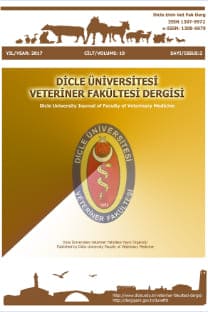Saha Şartlarında Gerçekleştirilen Suni Tohumlama Uygulamalarının Retrospektif Analizi
Anahtar Kelimeler:
Suni tohumlama, Saha şartları, İnekler
A Retrospective Analysis of Artificial Insemination Applications Carried out under Field Conditions
In this study, a retrospective analysis of 2516 artificial inseminations’ datas performed by three veterinarians in Elazig for the period 2003-2008 was presented. The used sperma doses of artificial insemination applications, Simental 57%, Brown-Swiss 31,7%, Holstein Friesian 10,9% and Limousin 0.4% breeds were constituted. The artificial insemination applications were increased in Spring months. The pregnancy was achieved on 546 cows of 595 cows in 1004 artificial insemination applications. Pregnancy index was obtained as 1,8 and the pregnancy rate was turned out to be 54,4%. 160 cows for which first artificial insemination trial failed and a second insemination was applicated, ovulation stimulating methods (Ovsynch, GnRH , HCG) were yield a pregnancy success rate of 55,6%. On 42 cows which were possible endometritis, post-breeding that is applied after artificial insemination yields a pregnancy success rate of 50% was attained. For the PGF2α applied on 67 cows which were suspected to have luteal cyst and exhibited anoestrus, a pregnancy success rate of 16,4% was achieved. For the GnRH applied on 78 cows which were suspected to have follicular cyst and exhibit irregular oestrus, a pregnancy success rate of 59% was achieved. Moreover, 52 cows which have metritis and antibiotic treatment was applied, a success rate of 51,9% was attained. To conclude, artificial insemination followup was insufficient under field conditions and veterinarians could have realized applications to increase fertility within the existing facilities which were parallel to the current researches.
Keywords:
Artificial insemination, Field conditions, Cows,
- ISSN: 1307-9972
- Yayın Aralığı: Yılda 2 Sayı
- Başlangıç: 2008
- Yayıncı: Dicle Üniversitesi Veteriner Fakültesi
Sayıdaki Diğer Makaleler
Sığırlarda Karın Şişkinliklerinde Müdahale Yöntemleri ve İlaç Uygulamaları
Saha Şartlarında Tedavi Edilen Retensio Sekundinarum Vakalarının Fertilite Üzerine Etkileri
Marek Hastalığı Teşhisinde Histokimyasal ve Histopatolojik Bulguların Değerlendirilmesi
M. Kemal Çiftçi, İlhami Çelik, Mehmet Tuzcu, Emrah Sur, Ertan Oruç
Berna Güney Saruhan, M. Erdem Akbalık, Hakan Sağsöz, M. Aydın Ketani
Saha Şartlarında Gerçekleştirilen Suni Tohumlama Uygulamalarının Retrospektif Analizi
